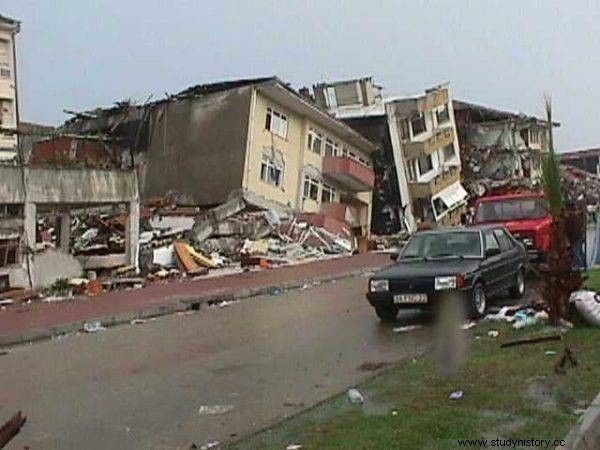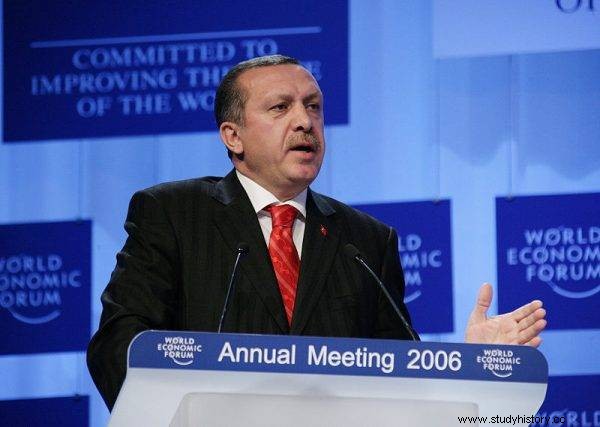"Buildings are bursting and falling with a roar that drowns out screams of terror. Forty-five seconds of a world collapsing. And then only dust, ”describes Agnieszka Rostkowska. Two decades ago, powerful shocks razed the Turkish Marmara region to the ground, claiming tens of thousands of lives. The New Turkey is born on its ruins.
August 17, 1999 went down as a dark day in Turkish history. It was the worst catastrophe since the end of World War II.
Two minutes after 3 a.m., the people of the Marmara region were awakened by violent tremors. The 7.5 earthquake turned out to be tragic. Total casualties:over 17,000 dead and almost 24,000 wounded. Officially, because unofficial statistics say about 45,000 fatalities and as many injured. Over half a million Turks are left homeless.
Act one:Gölcük
The epicenter was in Gölcük (near Izmit), but the tremors were also felt in Istanbul, 70 kilometers away. Joanna Pasztelańska, who was present at the time, reports:“It was said that the city that suffered the most - Gölcük - practically ceased to exist. (…) We didn't know what we would find there. Will we find anything. ”
The town, inhabited by over 55,000 people, was razed to the ground in less than a minute. It is estimated that on that tragic day, one fifth of the city's population (approx. 10,000 people) died. The reporter describes:
With the first rays of the sun, we sensed a quake. Literally, with the nose. Corpses decompose very quickly in thirty-six degree heat. In the scorching sun and wandering dust from the demolished houses, the sweet, slightly sour smell seems almost natural. But it will only get stronger with each passing hour.

Destroyed buildings in Izmit
There are only piles of rubble left of many buildings. In the following days, hardly anyone had the courage to spend the night indoors. For fear of aftershocks, people slept outside - on salvaged furniture scraps, unrolled carpets or directly on the bare ground.
Polish rescuers from Gdańsk and Nowy Sącz also helped in eliminating the consequences of the disaster. When, several weeks later, it seemed that the situation was gradually normalizing, the second act of the drama took place.
Big rebuild plan
Another strong quake in 1999 in Turkey occurred on November 12. This time the shocks of magnitude 7.2 did not wake anyone up - the ground began to tremble at 6:57 pm. It all took only 30 seconds. The result of the clash between man and nature - 845 killed and 4,948 wounded.
The "culprit" of these disasters is the North Anatolian fault between the tectonic plates, stretching through northern Turkey. A fragment of it runs only 20 kilometers from Istanbul and it reminds you of itself regularly. The last major earthquakes occurred there in 1506 and 1766. Agnieszka Rostkowska in the book "Warriors with glass eyes. In search of a New Turkey, he writes:Time for another [cruel spectacle - ed. ed.]. Professor Ziyadin Çakır of the Istanbul Technical University's geology department estimates that at least one hundred thousand people will die if the quake reaches a magnitude of 7.4. Other experts give even higher figures. ”
The only question remains:when will it happen?

The text is based on Agnieszka Rostkowska's book "Warriors with Glass Eyes. In search of a New Turkey ”, which has just been released by Wydawnictwo Poznańskie.
After the drama that unfolded in 1999, the authorities realized the need for change with full force:Turkey was completely unprepared for this type of disaster. Housing estates gecekondu ("Built at night", quickly erected, without authorization and with unsuitable materials) and poor-quality (albeit legal) blocks of flats, although they provided makeshift shelter to many citizens, were in fact deadly traps. It couldn't be like that anymore. Agnieszka Rostkowska reports:
These tragic events paved the way kentsel dönüşüm , a grand redevelopment and revitalization plan that will strengthen non-shock-resistant buildings across the country.
In practice, that means demolishing and rebuilding. Three hundred thousand safe buildings a year - this is the minimum goal of the Ministry of Environment and Urbanization. It is estimated that in Istanbul alone, such a fate may befall as many as three-quarters of buildings. All this to cheat destiny.
Cleaning of "dirt"
As soon as Recep Tayyip Erdoğan's Justice and Development Party (AKP) came to power, a large-scale project to rebuild the country was launched on the pretext of securing it from further earthquakes. Agnieszka Rostkowska writes:
The new government has bet on the economy, believing that nothing will fuel it like the construction sector. All possible mechanisms were activated to excite him. The risk of an earthquake was treated as a gift from heaven.
Companies implementing kentsel dönüşüm in areas identified as threatened by catastrophe they buy houses and flats from their current owners (they dispossess the reluctant ones by force) and then… storm them. Only that they treat objects that constitute a real danger as well as new buildings erected in accordance with safety rules and architectural monuments of great historical value.

When Recep Tayyip Erdoğan's Justice and Development Party (AKP) came to power, a large-scale project to rebuild the country began.
There is another problem. Agnieszka Rostkowska in the book "Warriors with glass eyes. In search of a New Turkey ”he emphasizes:“ Specialists in kentsel dönüşüm , the reconstruction of Turkey, have been saying bluntly for years that the actions of the Turkish authorities resemble ethnic cleansing ”.
Why? First of all, because the grand redevelopment plan covers those neighborhoods that have been dominated by minorities in the first place. The residents are of the same opinion. One of the heroes of Agnieszka Rostkowska's report grimly comments:"It's not about rebuilding the city, but about cleaning it of the dirt they think we are."
Bibliography:
- A. Rostkowska, "Warriors with glass eyes. In search of a New Turkey ”, Wydawnictwo Poznańskie 2020.
- J. Pasztelańska, R. Pasztelański, "Firefighters", Znak Horyzont 2018.
